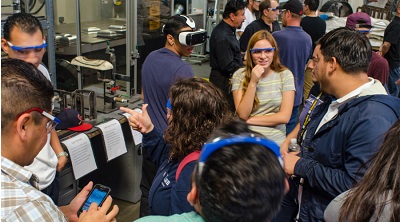MIT and ASU serve up an online Master’s in supply chain management
Graduates of the program will receive training at both institutions

What could be better than a graduate level education from one of the country’s best supply chain management programs? How about a graduate degree with training from two of the country’s best supply chain management programs.
In some respects, that’s the rationale behind a 100% online Master’s program offered on the edX platform that was recently announced by MIT and Arizona State University, ranked numbers 2 and 3 on U.S News & World Report’s annual ranking of graduate supply chain management programs. The online Master of Science in Supply Chain Management from ASU will launch in January 2020. The program is open only to students who have completed the MITx MicroMasters program credential from the MIT Center for Transportation and Logistics. After completing the five MicroMasters courses with MIT, students will take an additional six courses from Arizona State.
Qualifying students can apply now for the degree program, with an application deadline of Dec. 16, 2019. The cost of the program will be $19,080. You can learn more about the program here.
While a partnership between an Ivy League institution like MIT and a leading public university like Arizona State may seem like an odd pairing, faculty from both institutions note that the concept began with a conversation between the leadership of the two schools. At the time, ASU was already recognized for its online graduate programs, but was being asked to create MicroMasters type curriculum for corporate clients, such as Chemonics, an international aid and development firm that asked ASU to develop coursework in global supply chain management. “At the department, we were looking at strategies to get these people back to complete their master’s,” says Mohan Gopalakrishnan, the chair of ASU’s supply chain management program. “Our president asked us to to look at the MIT program as a benchmark to move forward.”
Meanwhile, although recognized as an innovator of massively open online courses (MOOCs), including its MITx MicroMasters program, MIT did not offer an online graduate degree. MIT’s leadership was interested in what ASU was doing with its online master’s program.
What followed was a series of meetings between faculties from the two schools “to see how we could blend together what we both do and create a master’s program we can all be proud of,” notes John Fowler, a supply chain management professor at ASU and director of the new program. Accommodations and adjustments were made: For instance, as a rule a student can’t transfer in more than 9 hours from another program and the MIT credential represents 12 hours of class time. Then they built the curriculum. Students will take courses in basic operations, logistics, supply chain design, cost management and analytics at MIT followed by strategic procurement, negotiation, a second class in logistics, project management, sustainability and social responsibility and finally, advanced operations with a capstone project. The focus is on the end-to-end supply chain.
Fowler estimates that it will take about 16 months to complete the degree after earning the MIT credential. And, students will go through both programs on the edX platform – MIT has partnerships with 21 other universities that will accept the apply the credential to credit, but only the ASU program will be 100 percent online and on the edX platform.
By all accounts, the program is a part of the revolution that is going on in education, including supply chain education. For starts, at less than $20,000, it’s very affordable. And, notes Eva Maria Ponce Cueto, executive director of the MicroMasters program, its accessible. “It’s really open to anyone from anywhere and any background,” she says. “We’ve had students from 100 countries and its very flexible. Most of our students have full-time jobs and they can do this after work.”
What’s more, “MIT and Arizona have their own networks of alumni and corporate partners,” says Chris Caplice, executive director of the MIT Center for Transportation and Logistics. “Students will double their exposure.” Students will also experience two different styles of teaching between the institutions, Caplice notes, including the large classes of MIT’s MOOCs and the smaller interaction possible in the ASU courses.
And, these types of partnerships might be a sign of things to come. “I can envision where in the future, more universities will cooperate like this, and you’ll take courses from four or five institutions to earn a degree,” says Fowler. “With this program, we might be seeing baby steps towards that.”

Article Topics
Blogs News & Resources
60 Seconds with Bob Trebilcock, outgoing executive editor, Modern Materials Handling Learn from lift truck service history Two voices of reason on pallet materials The reBound Podcast: How Pitney-Bowes is innovating with autonomous vehicles. Packaging Corner: Be open to change 60 Seconds with Robert Martichenko of American Logistics Aid Network The reBound Podcast: Looking for talent in all the right places: How Essendant is revolutionizing recruitment More BlogsLatest in Materials Handling
Registration open for Pack Expo International 2024 Walmart chooses Swisslog AS/RS and software for third milk processing facility NetLogistik partners with Vuzix subsidiary Moviynt to offer mobility solutions for warehouses Materials Handling Robotics: The new world of heterogeneous robotic integration BSLBATT is looking for new distributors and resellers worldwide Lucas Watson appointed CSO for Körber’s Parcel Logistics business in North America Hyster recognizes Dealers of Distinction for 2023 More Materials HandlingAbout the Author
Subscribe to Materials Handling Magazine

Find out what the world's most innovative companies are doing to improve productivity in their plants and distribution centers.
Start your FREE subscription today.
April 2024 Modern Materials Handling

Latest Resources










